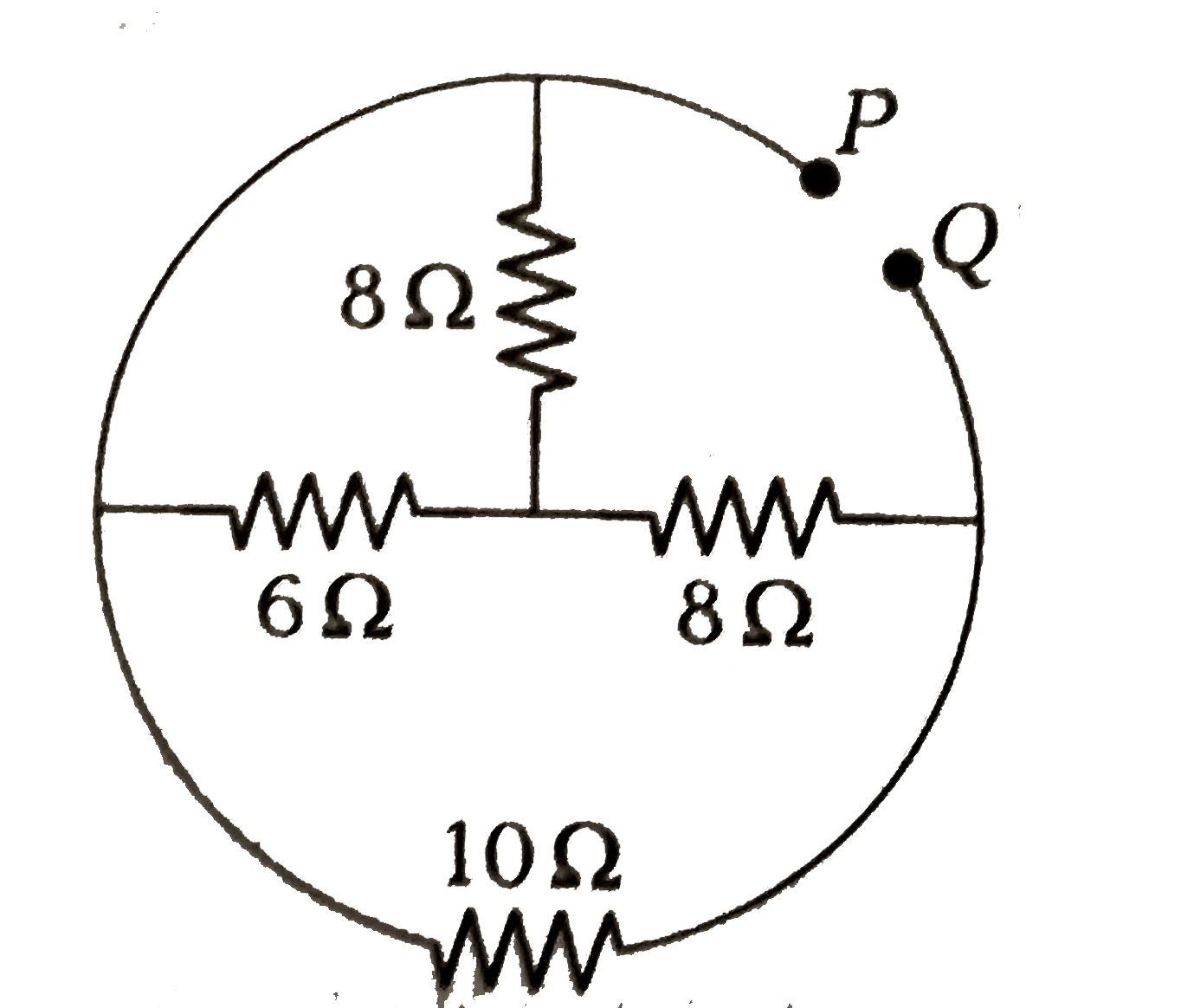Find the equivalent resistance between P and Q.
(##ARH_NEET_PHY_OBJ_V02_C03_S01_032_Q01.png" width="80%">
To find the equivalent resistance between points P and Q in the given circuit, we will follow these steps:
Step 1: Identify the resistors in series
First, we observe that there are two resistors (10 ohms each) connected in series. The equivalent resistance Rs for resistors in series is calculated by simply adding their resistances together.
Rs=R1+R2=10Ω+10Ω=20Ω
Step 2: Identify the resistors in parallel
Next, we look at the equivalent resistance of the combination of the 20 ohm resistor (from Step 1) and the 5 ohm resistor, which are connected in parallel. The formula for equivalent resistance Rp for resistors in parallel is given by:
1Rp=1R1+1R2
Substituting the values:
1Rp=120Ω+15Ω
Calculating the right-hand side:
1Rp=120+420=520
Thus,
Rp=205=4Ω
Step 3: Combine the remaining resistors in series
Now we have the equivalent resistance of 4 ohms (from Step 2) in series with the 3 ohm and 2 ohm resistors. The total equivalent resistance Rtotal is given by:
Rtotal=Rp+R3+R2
Substituting the values:
Rtotal=4Ω+3Ω+2Ω=9Ω
Final Answer
The equivalent resistance between points P and Q is:
Req=9Ω
---
First, we observe that there are two resistors (10 ohms each) connected in series. The equivalent resistance Rs for resistors in series is calculated by simply adding their resistances together.
Next, we look at the equivalent resistance of the combination of the 20 ohm resistor (from Step 1) and the 5 ohm resistor, which are connected in parallel. The formula for equivalent resistance Rp for resistors in parallel is given by:
Now we have the equivalent resistance of 4 ohms (from Step 2) in series with the 3 ohm and 2 ohm resistors. The total equivalent resistance Rtotal is given by:
The equivalent resistance between points P and Q is:
Topper's Solved these Questions
- CURRENT ELECTRICITYBOOK - DC PANDEY ENGLISHCHAPTER - CURRENT ELECTRICITYEXERCISE - Check point
70 Videos
- CURRENT ELECTRICITYBOOK - DC PANDEY ENGLISHCHAPTER - CURRENT ELECTRICITYEXERCISE - Taking it together
142 Videos
- CURRENT ELECTRICITYBOOK - DC PANDEY ENGLISHCHAPTER - CURRENT ELECTRICITYEXERCISE - Level 2 Subjective
13 Videos
- COMMUNICATION SYSTEMBOOK - DC PANDEY ENGLISHCHAPTER - COMMUNICATION SYSTEMEXERCISE - Subjective
11 Videos
- ELECTROMAGNETIC INDUCTIONBOOK - DC PANDEY ENGLISHCHAPTER - ELECTROMAGNETIC INDUCTIONEXERCISE - Medical entrances gallery
25 Videos
Similar Questions
Knowledge Check
The unit cell with the given structure represents _______ crystal system.
(##NCERT_OBJ_FING_CHE_XII_PP_E01_001_Q01.png" width="80%">AcubicBorthorhombicCtetragonalDtrigonal
Two circular coils can be arranged in any of three situations shown in the figure. Their mutual inductance will be (a)
 (b)(##AAK_MCP_32_NEET_PHY_E32_012_Q02.png" width="80%"> (c)
(b)(##AAK_MCP_32_NEET_PHY_E32_012_Q02.png" width="80%"> (c)
View SolutionFig. shows a light (blue + red + green) incident on a prism and on a parallel sided glass slab. Complete the diagrams by drawing the refracted and the emergent rays.
(##SEL_RPG_ICSE_PHY_X_C06_SLV_001_Q01.png" width="80%">
View SolutionThe equivalent resistance between P and Q in the figure is approximately

View SolutionTwo cars A and B move in mutually perpendicular, directions as shown in the figure . Find vBA
(##AAK_T1_PHY_C02_SLV_051_Q01.png" width="80%">
View SolutionFrom a point 20 m away from the foot of a tower, the angle of elevation of the top of the tower is 30∘. Find the height of the tower.
View SolutionTwo unequal circles with centres A and B intersect each other at points C and D. The centre B of the smaller circles lies on the circumference of the bigger circle with centre A. If ∠CMD=x∘, find in terms of x, the measure of angle DAC .
(##SEL_RKB_ICSE_MAT_X_C17_E01_013_Q01.png" width="80%">
View SolutionCalculate the equivalent resistance between P and Q from the following diagram

View Solution

